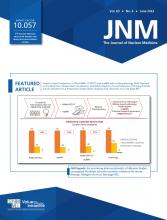D. Volterrani, P.A. Erba, I. Carrió, H.W. Strauss, and G. Mariani, eds.
Springer, 2019, 1,331 pages, $179.99
Nuclear medicine is a small specialty, but it has been and continues to be one of the most innovative and exciting branches of medicine. Nuclear medicine combines biology, chemistry, physics, and mathematics with the art and science of clinical medicine. Tracer-principle–based radiopharmaceutical therapy and diagnosis, which may be targeted and integrated systematically in the form of theranostics, may be applied to all major organ systems and disease processes. Theranostics was born about 80 years ago with radioiodine in the imaging and treatment of thyroid diseases. Therefore, whereas the concept is not new, it has undergone a renaissance with the development of novel agents for imaging and targeted radionuclide therapy of cancer (e.g., neuroendocrine tumors, prostate cancer, and pheochromocytoma/paraganglioma). Other agents are anticipated relatively soon that are targeted to chemokine receptors and fibroblast activation protein, with the list expanding as further biologic insights and biomarker developments emerge. Nuclear medicine and theranostics are also anticipated to cultivate a rational link between precision health and precision medicine.
There have been many comprehensive textbooks published on the science and clinical practice of nuclear medicine. However, nuclear medicine is a fast-advancing field that demands new textbooks or relatively frequent updates to the ones previously published. Here, I review a book published by Springer in 2019. The book is entitled Nuclear Medicine Textbook: Methodology and Clinical Applications and is edited by five renowned academic experts in nuclear medicine: three from the University of Pisa, one from the Autonomous University of Barcelona (past editor of the European Journal of Nuclear Medicine and Molecular Imaging), and one from Cornell University Weill (past editor of The Journal of Nuclear Medicine and past president of the Society of Nuclear Medicine and Molecular Imaging). The editors also contributed as coauthors to several chapters, along with a remarkable 122 invited international contributors, most from Italy but also contributors from Austria, Germany, Japan, Jordan, Spain, Sweden, The Netherlands, and the United States.
This comprehensive book is structured into 51 chapters organized as 3 parts and encompasses 1,331 pages, with numerous tables, graphs, diagrams, and high-quality images, many in color. Part I, on basic science, includes 16 chapters covering a brief history of radiation and radioactivity; radiation physics and radiation protection; radiopharmaceuticals (categorized conveniently under single-photon–emitting, positron-emitting, and therapy); instrumentation, including camera systems; image data acquisition; processing and quantification techniques; and principles and interpretation of CT and MRI as an introduction to hybrid imaging. Part I culminates with an expedient summary of radioguided biopsy and surgery in the relevant clinical scenarios. Part II, on clinical applications, has 22 chapters covering all major organ system diseases in both adults and children, with an emphasis on hybrid imaging, including a chapter on the expanding utility of PET/CT in dose painting and radiation treatment planning in several malignancies. Part III, on practice and procedures, contains 13 chapters and provides useful ancillary information on the radiochemistry of single-photon–emitting and positron-emitting radiopharmaceuticals, their quality assurance procedures, their regulatory processes in both Europe and the United States, quality control of instrumentation and camera systems, practice guidelines for major nuclear medicine procedures, and dual-energy x-ray absorptiometry for assessment of bone mineral density. Part III closes with 36 nononcologic and 42 oncologic illustrative teaching cases (mostly 18F-FDG PET, with a few cases of 18F-FDOPA and 18F-fluorocholine PET) and techniques for optimal image interpretation, along with concise and informative reporting of results, including sample reports for 56 different clinical scenarios and nuclear medicine procedures. Each chapter includes learning objectives and key learning points, with cited references or additional suggested readings. The book ends with a convenient glossary of abbreviated terms and a detailed index.
This practical book is particularly useful for trainees but is also of considerable value to seasoned physicians in nuclear medicine or radiology and to practitioners in other branches of medicine and surgery interested in the applicability of nuclear medicine procedures to their disciplines. Other professionals, including technologists, medical physicists, and radiation safety officers, can also benefit from this textbook. This book will be a great resource in the library of any clinical department or medical school.
In the end, I paraphrase a frequently repeated quotation from the Californian public television personality Huell Howser (1945–2013), who, in his “California’s Gold” program, explored the natural, cultural, and historical features of California. He always ended this program by saying, “…and this is truly a fine example of California’s gold.” In that same spirit, I must say that Nuclear Medicine Textbook: Methodology and Clinical Applications is a fine example of nuclear medicine’s gold.
Footnotes
Published online Dec. 9, 2021
- © 2022 by the Society of Nuclear Medicine and Molecular Imaging.







